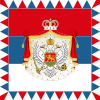Vasilije Petrović
Vasilije Petrović | |
|---|---|
| Metropolitan of Montenegro | |
 | |
| Church | Serbian Patriarchate of Peć |
| Metropolis | Cetinje |
| See | Cetinje |
| Installed | 1744 |
| Term ended | 1766 |
| Personal details | |
| Born | 1709 |
| Died | March 10, 1766 (aged 56–57) St. Petersburg, Russian Empire (now Russia) |
| Denomination | Eastern Orthodox Christianity |
| Coat of arms |  |
Vasilije Petrović (Serbian Cyrillic: Василије Петровић; 1709 – 10 March 1766) was the metropolitan bishop of Cetinje (Prince-Bishop of Montenegro), ruling with Sava Petrović, his cousin. He was author of the History of Montenegro, published in 1754.
Political background[edit]
The modern political history of Montenegro began with Metropolitan Danilo, who founded a state ruled by a dynasty from the Petrović-Njegoš family. Danilo was eventually succeeded by his two nephews, first by Sava Petrović, and then by Vasilije.[1]
Bishop Sava was a secluded person, and dedicated himself more to religion than to politics. He had some influence among the tribesmen of Montenegro. He advocated for Montenegrin dependence on Russia as a means of defeating the Ottoman Empire and achieving statehood for Montenegro.[1] He also maintained good relations with the Republic of Venice.[2]
Term[edit]
During his term, Vasilije ruled together with Sava, his brother, as his coadjutor. Between 1750 and 1766 he unsuccessfully tried to convince Austria's Maria Theresa that "since the time of Alexander the Great" Montenegro had been a "separate republic.. [over which] rules her metropolitan".[3]
From 1752 to 1754, he stayed in Russia and thereafter made additional trips to gain Russian assistance. With the help of Russian arms, he went to war with the Turks and then had to seek refuge back to Russia. In 1766 while in St. Petersburg, he died of pneumonia.[1]
Aftermath[edit]
After Vasilije, Sava took power and continued with the same foreign policy as before, allying himself with Venice. That did not last long however, as Šćepan Mali who, claiming to be the Russian Tsar Peter III himself, managed to convince the people that he should rule Montenegro.[1]
He immediately severed ties with Venice altogether, implemented the strict rule of law, began building roads until his life was cut short in 1773 by an assassin sent by the Vizier of Skadar.[1][4][5]
Sava returned to serve as metropolitan once again, and after him his nephew, Arsenije Plamenac of Crmnica, became metropolitan. But Arsenije, too, was soon to die, in 1784. Once again a member of the Petrović-Njegoš, now Petar I Petrović-Njegoš, was inaugurated.[1]
Literary works[edit]
The writing and teaching of Montenegrin history was a chief interest for most of Vasilije's life, as well as his occupation as a spiritual leader. Istorija o Černoj Gori (History of Montenegro), published in St. Petersburg in 1754, is his most renowned work.[6] Through accounts from ordinary citizens, the book represented the first attempt to write the history of Montenegro.[2][1] It was an effort on the part of Vasilije to gain Russian political support for Montenegro against the Ottomans by highlighting and mythologizing Montenegrin struggles.[6][2] It put forth the idea of Montenegrin independence for the first time, though it did not have a large immediate impact.[7] Parts of the Cetinje chronicle are also attributed to him.
Bibliography[edit]
- History of Montenegro (Serbian Cyrillic: Историја о Черној Гори)
- Ode to Nemanja (Serbian Cyrillic: Похвала Немањи)
Title[edit]
- Metropolitan of Montenegro, Skenderija and Primorje, and Exarch of the Serb throne (smjerni mitropolit crnogorski, skenderijski i primorski i trona srpskoga egzarh)[8]
References[edit]
- ^ a b c d e f g Pavlovic, Srdja (2008). Balkan Anschluss: The Annexation of Montenegro and the Creation of the Common South Slavic State. Purdue University Press. pp. 33–36. ISBN 9781557534651.
- ^ a b c Roberts, Elizabeth (2007). Realm of the Black Mountain: A History of Montenegro. Cornell University Press. pp. 148–149. ISBN 9780801446016.
- ^ Banac, Ivo (2015). The National Question in Yugoslavia: Origins, History, Politics. Cornell University Press. p. 274. ISBN 9781501701948.
- ^ Diamond, Neil; Knežević, Marija, eds. (2017). Images of Montenegro in Anglo-American Creative Writing and Film. Cambridge Scholars Publishing. p. 10. ISBN 9781443862707.
- ^ Ivetic, Egidio (2022). History of the Adriatic: A Sea and Its Civilization. John Wiley & Sons. p. 55. ISBN 9781509552535.
- ^ a b Mitev, Plamen (2010). Empires and Peninsulas: Southeastern Europe Between Karlowitz and the Peace of Adrianople, 1699-1829. LIT Verlag Münster. p. 91. ISBN 9783643106117.
- ^ Banovic, Branko (2016). The Montenegrin Warrior Tradition: Questions and Controversies over NATO Membership. Springer. p. 49. ISBN 9781137552280.
- ^ "Projekat Rastko Cetinje - Vasilije Petrovic Njegos - Istorija o Crnoj Gori". Archived from the original on 2014-12-05. Retrieved 2014-11-27.
External links[edit]
- 1709 births
- Serbian Orthodox metropolitans of Montenegro
- 1766 deaths
- 18th-century Eastern Orthodox bishops
- Petrović-Njegoš dynasty
- Prince-bishops of Montenegro
- Bishops of Montenegro and the Littoral
- Serbs of Montenegro
- Serbian male poets
- Serbian writers
- Writers from Cetinje
- Monarchs of Montenegro
- Burials at the Annunciation Church of the Alexander Nevsky Lavra
- Clergy from Cetinje




